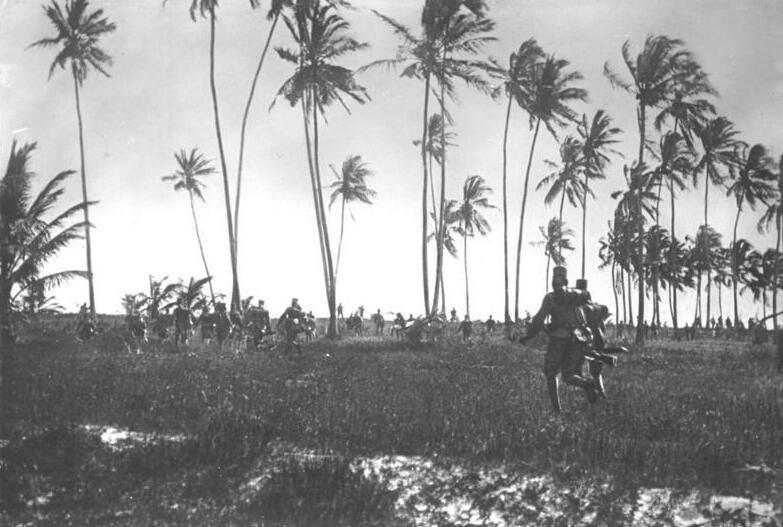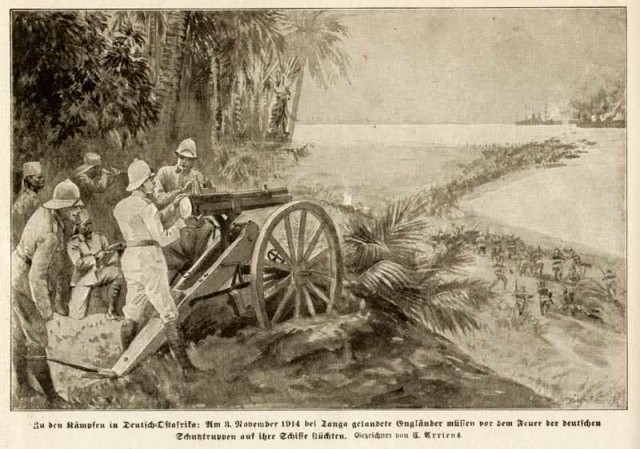
The Invasion
Force
As
the first skirmishes broke out on land and at sea, the British Empire prepared a
death blow to German East Africa. Given the rapid successes mounting against
Germany’s other colonies, it expected much to be accomplished with one hastily
assembled force. This force was Indian Expeditionary Force B. Assembled in
India, it soon was stripped of many of its best men and top-notch gear. These
resources were diverted to deal with the oncoming entrance of the Ottoman
Empire on Germany’s side. Indian Expeditionary Force B was led by General Arthur
Edward Aitken of the Indian Army. He had not done much of note in his career, but
had good familial and political connections. This gave him a command position, albeit
one in a sideshow. Originally IEF B was built around Aitken’s own 16th
Poona Brigade, and his mission was to seize Dar-es-Salaam and its radio
station. However, the 16th Poona Brigade was taken away, while his
superiors gave him a far more ambitious plan. He was to land his force at the
port town of Tanga. After seizing it, he was to move north towards Stewart’s
IEF C, which was currently squaring off against Lettow-Vorbeck, and secure the
colonial border. After this he was to conquer all of German East Africa. Like
many of the famed British military disasters of history, the upcoming campaign
was to be undone by an incredible stream of horrible decisions and terrible
luck.
Replacing
the Poona Brigade was the 27th Bangalore Brigade under General Richard
Wapshare (but sans its cavalry, artillery, and pioneers which were redirected
elsewhere). This was the only brigade in the force to hold an all-British
battalion, the Loyal North Lancashires. One Regular Army brigade was added,
with the 63rd Palamcottah Light Infantry and the 98th
Infantry. The infantry was further filled out with Imperial Service troopers.
These were not part of the British army, but soldiers assigned to various
Indian princes. They had practically been private security forces and
inexperienced in true warfare. Those that were borrowed were placed in a
brigade under Brigadier General Tighe. The Indian Service units had originally
been equipped with outdated Lee-Enfield long rifles and had barely any time to
adjust to the newer shorter models handed out before the East Africa invasion.
They did not have machine guns at all. A few finally got the weapons, but at the last
minute and with no time to properly train. Finally Aitken was given the 61st
King George’s Own Pioneers, the 28th Indian Mountain Battery, and
various small detachments of support personnel such as railway specialists and
signalmen. All of these units would not consolidate until they arrived at
Tanga, making it impossible for Aitken to study his force as whole and
reorganize it accordingly.
Aitken
should have felt more concern with the hastiness in which IEF B was cobbled
together and sent into action. However, his confidence was booming due to optimistic intelligence. Agents reported that the colonists in German East Africa did not
want a war, valuing their private enterprises over Germany. After all, the main
show was in Europe. They further reported that the various native groups were
simmering with resentment after such events as the Maji-Maji Rebellion and
would revolt at the first good opportunity. In addition to this optimistic
assessment, Aitken and many of his subordinates were blinded by the racism of
the time. Among his intelligence officers was Richard Meinertzhagen. Meinertzhagen’s Army Diary would prove to be one of the
most popular primary sources both for its in-depth analysis of the British side
of the East African campaign, as well as for its many colorful stories. Many
writers have taken Meinertzhagen at face value, but some of his entertaining
anecdotes should be taken with a grain of salt. He also positions himself as
the voice of reason among an inept British command, but there is basis for
this. He had spent time with the King’s African Rifles in British East Africa
and thus knew of the native blacks’ advantage on their home turf. He warned
Aitken that the Askaris of the Schutztruppe were not to be underestimated
considering their natural advantages. Aitken dismissed him, citing the supposed
superiority of both Europeans and Indians over Africans. “The Indian Army will
make short work of a lot of niggers.”
Bad Timing
The
Tanga Expedition was battered before it even caught sight of the enemy. The
transports had to take their time organizing into a convoy under the protection
of the war ships HMS Fox and HMS Goliath. The German raider Konigsberg was still active and keeping
the Royal Navy on its toes. The thousands of troops packed onto the transports
suffered from sweltering heat. Diarrhea spread alongside rampant sea sickness. Horrendous timing offset the
expedition’s element of surprise. First Aitken, once the convoy was underway, failed to give General
Stewart of IEF C a proper heads-up. Stewart was now already behind in preparing
his force for its own offensive. This would give Lettow-Vorbeck the breathing
space he needed to rush to Tanga’s defense. Then Captain Caulfield steamed the Fox far ahead of the convoy into Tanga’s
harbor. Caulfield had suggested to Aitken that they should inform Tanga that
the truces with the port towns were over and that it should surrender. By going
ahead and demanding capitulation, Caulfield alerted the inhabitants of Tanga to
a highly likely invasion. He also bluntly asked if the waters around Tanga were
mined, and was falsely told yes. This resulted in unwarranted caution.
The
element of surprise was now lost, but Tanga was still vulnerable. In its
defense it only had the 250-man local police force, and outdated guns. But
Aitken squandered his opportunity. He wasted valuable time trying to arrange a
surrender with the Tanga’s leader, Dr. Auracher. Auracher was given an
ultimatum: surrender by a certain time or suffer bombardment. Auracher
contacted both Colonel Lettow-Vorbeck and Governor Schnee for advice. This
resulted in two diametrically opposed orders. Lettow-Vorbeck, alarmed, told him
to stand firm while he hastily extricated his force from the British East
African border. Then he could bring them Tanga’s defense. Schnee ordered him to
acquiesce and surrender the town. Auracher now had a choice between the military
authority and his civilian superior Schnee. He defiantly chose the former
course, ordering all non-combatants evacuated. When he failed to meet the
deadline for surrender, Aitken and Caulfield generously extended it. This
bought the Germans more time. The British, displaying overconfidence, moved
sluggishly while the Germans wasted no time.
Another
ill befell IEF B. The HMS Goliath had
broken down and was not able to make it into the harbor with the HMS Fox. This seriously reduced British firepower. Also, the command staff could find no room on the other
ships and had to split up, resulting in difficult communications.
The Landing
The
British continued to move slowly as they searched for a spot to land. Tanga’s
docks were in shallow waters. Heavy merchant ships had to use lighters to bring
goods to port and now IEF B was having similar issues. Around the port town was
dense vegetation, with rubber plantations and beehives to the south and east.
The beaches were scrunched between dense mangrove swamps and cliffs, creating
narrow landing sites. Aitken saw two possible landing sites in decent range. He
ruled one out because it was in the range of Tanga’s artillery. The other beach
was a small one on the east side of the peninsula, protected from Tanga’s line
of fire. Still believing that the waters were mined, the British lost more time
mine-sweeping.
The
actual landing, which started on November 2, was slow and uncoordinated, with
Tighe’s Indian Service Brigade taking the lead. The landing was unopposed, the
Germans still bringing in reinforcements. Arriving himself, Lettow-Vorbeck took
charge and quickly scouted out the area (Aitken failed to implement any
reconnaissance at all). He was pleased with the heavy bush, which not only
provided good defensive cover but played to his Askaris’ strength. There was
also enough room to for offensive, pointed
maneuvers. He said after the war that his bush-fighting ideas were unpopular
with his subordinates and that if he had failed it would have been the end of
his ability to command his men.
On November 3 there was light skirmishing. By November 4 the
Germans had about 1,000 men to IEF B’s 9,000. Even with the enemy’s cavalcade of
blunders, only superior tactics and use of the terrain could win this fight. Up
north, Stewart’s IEF C of 4,000 men moved on the now undermanned Kilimanjaro
area. However, it was not as undermanned as the British thought. They expected
a couple hundred Askaris, but at Longido it ran into 600 plus hastily assembled German
colonists. 1,500 Punjabis were ambushed while walking through a morning fog.
The Punjabis launched further attacks, but conceded defeat with over 300
casualties. The Germans lost over 100.
The
Battle of the Bees

Tanga’s
police force was pushed back by the Indian Service Brigade. The tide quickly
turned when a Schutztruppe contingent launched a counter-attack. The Indian
Service Troops fell into a chaotic state, according to Meinertzhagen “running
like rabbits and jabbering like monkeys.” The fleeing Indians received supporting
fire from the HMS Fox. The Fox’s gunners soon stopped, though, as
with the dense vegetation they could not aim properly. IEF B did make some
gains in spite of the panic of the more inexperienced Indians. The more
competent Kashmir Rifles (made up of Gurkhas), seized the customs house well
as the hospital. The HMS Fox resumed
firing, aiming at the center of the town. It was the only safe spot to bombard,
as the German and Askari troops in the town were engaged in close quarters, house-to-house fighting. The British advance here was halted when two European Schutztruppe
companies under Captain Tom von Prince rushed in and swept the streets with
machine gun fire. Though rescuing the fight in the town, Prince was himself
shot and killed, one of many German officers lost in the battle.
 |
| Askaris in action. This photo is believed to have been taken at the Battle of Tanga. |
Outside
the town, Lettow-Vorbeck’s rapid preparations were paying off. Snipers in trees
picked off enemy troops. Machine guns behind barbed wire barriers blocked every
route of advance. The Schutztruppe had even set up a telephone system so the
officers could easily communicate and coordinate their moves. The Indian
Service Troops continued to perform poorly, breaking and running despite the
angry curses and orders of their British officers. Yet the battle was still
winnable, with other IEF B units spending the afternoon locked in
jungle-fighting with Lettow-Vorbeck’s Askaris. Then a third force entered the
fray.
Part
of the battle had concentrated around the bee hives. Disturbed and irate at all
the fighting which threatened their homes, the bees swarmed out to do battle
themselves. They attacked both sides. The German machine guns were silenced as
the crews were harried, but the British and Indians got the worst of it. This
onslaught was enough to send them into a pell-mell retreat, Askaris shooting
them in the back at the same time. The bees pursued them and were led into the
next row of soldiers, spreading the storm of stings. Many were so desperate to
get away that they ran all the way to the sea to jump in. The number of stings
that they received was tremendous, one soldier receiving at least 300. These
were also African bees, larger and more dangerous than their counterparts on
other continents. The bees had disorganized the British assault and given the
Schutztruppe a breather to reorganize and strengthen their positions.

In
all the confusion from the town fighting and the bees, the men in the IEF B
began to accidentally shoot each other. The HMS
Fox was not excused from friendly fire either. One of its few confirmed
hits was against the hospital, which held wounded men from its own side.
Lettow-Vorbeck, observing that momentum had swung handily towards his side,
ordered an evening assault against his numerically superior foe. This assault
retook the town. Curiously the Germans then abandoned their gains. When an
Afrikaner serving with the Germans asked Lettow-Vorbeck the reason, it proved to be a miscommunication and the troops were quickly sent back in. As it
turned out, Aitken had no plans for seizing the exposed town. The commander, ashamed
of his own mistakes and disgusted with the miserable performance of his troops,
called off any plans to salvage the operation. He ordered a quick retreat IEF B
disembarked on November 5, leaving copious amounts of supplies to the
victorious Schutztruppe. Among these supplies were British rifles, machine
guns, and no less than 600,000 rounds of ammunition. The British fleet remained
a little longer. Meinertzhagen had called for a truce to collect the wounded.
The Germans quickly agreed, not wanting to divert resources to the care of
wounded British and Asians.
The Start of a
Long Campaign
The
Battle of Tanga was a turning point. A British invasion had been decisively
turned back. It was one of the bloodier encounters of the East African
campaign. Once the fighting stopped “the streets were
literally strewn with dead and badly wounded.” The wounded criedout for aid in a myriad of languages, reflecting the
multi-ethnicity of the two forces. The Germans suffered 144 casualties,
64 killed and 80 wounded. Lettow-Vorbeck “cautiously” estimated enemy losses at
2,000 (in his memoirs he corrected himself, saying this was “too low an estimate”).
In reality IEF B sustained the still heavy toll of 817, with 359 killed, 310
wounded, and 148 missing. German East Africans, elated by such a victory
against great odds, now rallied behind Lettow-Vorbeck. German East Africa gained the determination to resist the Entente forces for years, as long as
Lettow-Vorbeck could live up to expectations. Governor Schnee was not so happy.
He was concerned that a long, protracted war would now devastate his colony and
undo all his good work.
 |
| Indian prisoners after Tanga. They would be sent to camps further inland. |
On
the British side, Aitken showed commendable humility by apologizing to his
subordinates. He was demoted to colonel and after a long period of staying out
of action and collecting half pay, he resigned. Richard Wap-share was promoted
to his former position. British propaganda made much of the bees. They accused
the Germans of setting up tripwires that, when triggered, would shake the hives
and anger the bees. Lettow-Vorbeck was later asked about his “trained bees”,
amusedly denying the fact and pointing out that some of his own men were
attacked as well. German East Africa was still threatened. IEF C had still come
across the border and Lettow-Vorbeck had his eye northwards on the
British-occupied port of Jassin.
Next
Month: War Along the Railway! Lettow-Vorbeck’s next battle convinces him to
adopt his hit-and-run warfare wholesale. He targets the Usambara Railway, and
both sides fight not only each other, but thirst, dust, and the local fauna.
Sources
Crowson, Major Thomas A. When
Elephants Clash: A Critical Analysis of Major General Paul Emil von
Lettow-Vorbeck. Verdun Press, 2014.
Dane, Edmund. British
Campaigns in Africa and the Pacific, 1914-1918. London: Hodder and
Stoughton, 1919.
Farwell, Byron. The
Great War in Africa, 1914-1918. New York: Norton, 1986.
Gaudi, Robert. African
Kaiser: General Paul von Lettow-Vorbeck and the Great War in Africa, 1914-1918.
New York: Caliber, 2017.
Harvey, Major Kenneth J. Battle
of Tanga, German East Africa, 1914. Chicago: Verdun Press, 2014.
Heaton, Colin D., and Lewis, Anne-Marie. Four-War Boer: The Century and Life of Pieter Arnoldus Krueler.
Havertown: Casemate Publishers (Ignition), 2014.
Hoyt,
Edwin Palmer. Guerilla: Colonel von
Lettow-Vorbeck and Germany’s East African Empire. New York: Macmillan,
1981.
Lettow-Vorbeck, Paul. My
Reminiscences of East Africa. London: Hurst and Blackett, LTD., 1920. https://www.gutenberg.org/files/51746/51746-h/51746-h.htm
Miller, Charles. Battle
for the Bundu: The First World War in Africa. Macmillan Publishing Co.,
1974.
Paice, Edward. Tip
& Run: The Untold Tragedy of the Great War in Africa. Phoenix, 2008.
Reigel, Corey W. The
Last Great Safari: East Africa in World War I. Lanham, Maryland: Rowman
& Littlefield, 2015.
No comments:
Post a Comment